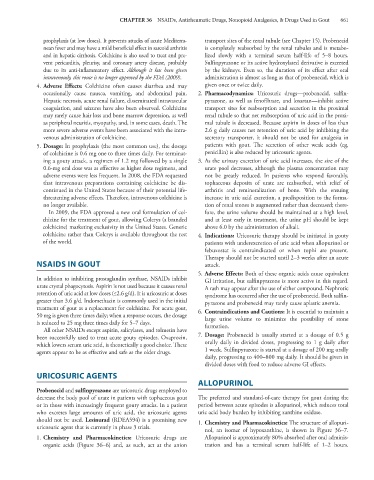Page 675 - Basic _ Clinical Pharmacology ( PDFDrive )
P. 675
CHAPTER 36 NSAIDs, Antirheumatic Drugs, Nonopioid Analgesics, & Drugs Used in Gout 661
prophylaxis (at low doses). It prevents attacks of acute Mediterra- transport sites of the renal tubule (see Chapter 15). Probenecid
nean fever and may have a mild beneficial effect in sarcoid arthritis is completely reabsorbed by the renal tubules and is metabo-
and in hepatic cirrhosis. Colchicine is also used to treat and pre- lized slowly with a terminal serum half-life of 5–8 hours.
vent pericarditis, pleurisy, and coronary artery disease, probably Sulfinpyrazone or its active hydroxylated derivative is excreted
due to its anti-inflammatory effect. Although it has been given by the kidneys. Even so, the duration of its effect after oral
intravenously, this route is no longer approved by the FDA (2009). administration is almost as long as that of probenecid, which is
4. Adverse Effects: Colchicine often causes diarrhea and may given once or twice daily.
occasionally cause nausea, vomiting, and abdominal pain. 2. Pharmacodynamics: Uricosuric drugs—probenecid, sulfin-
Hepatic necrosis, acute renal failure, disseminated intravascular pyrazone, as well as fenofibrate, and losartan—inhibit active
coagulation, and seizures have also been observed. Colchicine transport sites for reabsorption and secretion in the proximal
may rarely cause hair loss and bone marrow depression, as well renal tubule so that net reabsorption of uric acid in the proxi-
as peripheral neuritis, myopathy, and, in some cases, death. The mal tubule is decreased. Because aspirin in doses of less than
more severe adverse events have been associated with the intra- 2.6 g daily causes net retention of uric acid by inhibiting the
venous administration of colchicine. secretory transporter, it should not be used for analgesia in
5. Dosage: In prophylaxis (the most common use), the dosage patients with gout. The secretion of other weak acids (eg,
of colchicine is 0.6 mg one to three times daily. For terminat- penicillin) is also reduced by uricosuric agents.
ing a gouty attack, a regimen of 1.2 mg followed by a single 3. As the urinary excretion of uric acid increases, the size of the
0.6-mg oral dose was as effective as higher dose regimens, and urate pool decreases, although the plasma concentration may
adverse events were less frequent. In 2008, the FDA requested not be greatly reduced. In patients who respond favorably,
that intravenous preparations containing colchicine be dis- tophaceous deposits of urate are reabsorbed, with relief of
continued in the United States because of their potential life- arthritis and remineralization of bone. With the ensuing
threatening adverse effects. Therefore, intravenous colchicine is increase in uric acid excretion, a predisposition to the forma-
no longer available. tion of renal stones is augmented rather than decreased; there-
In 2009, the FDA approved a new oral formulation of col- fore, the urine volume should be maintained at a high level,
chicine for the treatment of gout, allowing Colcrys (a branded and at least early in treatment, the urine pH should be kept
colchicine) marketing exclusivity in the United States. Generic above 6.0 by the administration of alkali.
colchicine rather than Colcrys is available throughout the rest 4. Indications: Uricosuric therapy should be initiated in gouty
of the world. patients with underexcretion of uric acid when allopurinol or
febuxostat is contraindicated or when tophi are present.
Therapy should not be started until 2–3 weeks after an acute
NSAIDS IN GOUT attack.
5. Adverse Effects: Both of these organic acids cause equivalent
In addition to inhibiting prostaglandin synthase, NSAIDs inhibit GI irritation, but sulfinpyrazone is more active in this regard.
urate crystal phagocytosis. Aspirin is not used because it causes renal A rash may appear after the use of either compound. Nephrotic
retention of uric acid at low doses (≤2.6 g/d). It is uricosuric at doses syndrome has occurred after the use of probenecid. Both sulfin-
greater than 3.6 g/d. Indomethacin is commonly used in the initial pyrazone and probenecid may rarely cause aplastic anemia.
treatment of gout as a replacement for colchicine. For acute gout, 6. Contraindications and Cautions: It is essential to maintain a
50 mg is given three times daily; when a response occurs, the dosage large urine volume to minimize the possibility of stone
is reduced to 25 mg three times daily for 5–7 days. formation.
All other NSAIDs except aspirin, salicylates, and tolmetin have
been successfully used to treat acute gouty episodes. Oxaprozin, 7. Dosage: Probenecid is usually started at a dosage of 0.5 g
which lowers serum uric acid, is theoretically a good choice. These orally daily in divided doses, progressing to 1 g daily after
agents appear to be as effective and safe as the older drugs. 1 week. Sulfinpyrazone is started at a dosage of 200 mg orally
daily, progressing to 400–800 mg daily. It should be given in
divided doses with food to reduce adverse GI effects.
URICOSURIC AGENTS
ALLOPURINOL
Probenecid and sulfinpyrazone are uricosuric drugs employed to
decrease the body pool of urate in patients with tophaceous gout The preferred and standard-of-care therapy for gout during the
or in those with increasingly frequent gouty attacks. In a patient period between acute episodes is allopurinol, which reduces total
who excretes large amounts of uric acid, the uricosuric agents uric acid body burden by inhibiting xanthine oxidase.
should not be used. Lesinurad (RDEA594) is a promising new 1. Chemistry and Pharmacokinetics: The structure of allopuri-
uricosuric agent that is currently in phase 3 trials. nol, an isomer of hypoxanthine, is shown in Figure 36–7.
1. Chemistry and Pharmacokinetics: Uricosuric drugs are Allopurinol is approximately 80% absorbed after oral adminis-
organic acids (Figure 36–6) and, as such, act at the anion tration and has a terminal serum half-life of 1–2 hours.

